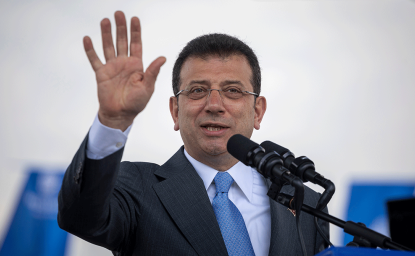149. Why Some Succeed and Others Fail: Eight Years of Transition In Eastern Europe

The spectacular collapse of state socialism in Eastern Europe in 1989 was greeted by social scientists and regional experts with considerable caution. The tasks facing the region in order to create liberal democracies and market economies seemed enormous. In the past, Eastern Europe functioned as the continent's unstable and backward periphery, and then it had been reshaped by decades of communist domination. By 1989, the region was experiencing fast economic decline. Any change was bound to be slow and difficult.
The first seven years of transition confirmed many of these initial fears and gloomy predictions. The collapse of Yugoslavia and the bloody civil war that followed became symbols of the danger inherent in dismantling communist dictatorships. Economic transition proved to be a costly process. Each country experienced severe recession, a contraction of industrial production, and a dramatic drop in GDP. The liberalization of the region's economies resulted in growing unemployment, rampant inflation, social dislocation, poverty, and rising inequality. Post-communist political life was plagued by conflict, political fragmentation, and instability. Reform efforts and policies were often inconsistent, delayed, and corrupted. The recurrent macroeconomic setbacks suffered by late reformers such as Bulgaria and Romania, the breakdown of the social and political order in Albania after its financial collapse, as well as the economic difficulties experienced by reform leaders such as the Czech Republic in 1997 or Hungary in 1994-95 show that dismantling state socialism has been full of dilemmas, difficulties, and potential hazards.
In spite of all this, the transformation unfolding in the region must be judged as surprisingly successful. New states have emerged without prolonged military conflicts and civil wars. Democratic institutions have been introduced and despite intense political struggles, lawfully elected parliaments and governments have gained power. The police and the armed forces have been reformed and placed firmly under the control of civilian authorities. Although political developments in Albania, Croatia and Slovakia have prompted serious concerns about political rights and liberties, for the most part new civil societies are firmly in place.
Several years after the collapse of communist rule, distinctive groups of countries with contrasting policies and accomplishments have emerged within the former Soviet bloc. Poland, the Czech Republic, Hungary, and Slovenia have been the most successful at enacting reforms and moving forward with transition. In contrast, progress has been much slower and more erratic in the Balkan countries and Slovakia. Finally, with the exception of the Baltic states, Russia and the former Soviet republics have accomplished little.
A whole array of factors explain why this divergence has taken place, as well as why some countries seem to have been more successful than others in the process of ongoing transformation. Even though transition processes are still unfolding, and it would be highly imprudent to overgeneralize the lessons of the early experiences, a number of patterns are clear. First, the countries with the most advanced and successful economic transformations have at the same time the most secure and effective democratic systems, as well as greater freedom and liberties. Thus, what transpires from the post-communist experience in Eastern Europe is that simultaneous transitions can only be successful when democracy is stronger, power less concentrated, electoral cycles shorter, government turnover more frequent, and the media free from the government control.
Second, all successful countries had earlier histories of political conflicts, liberalization attempts, economic reforms and experiments, and oppositional activities. Such developments under state socialism produced more pragmatic communist elites, more viable private domains within state-run economies, and stronger cultural and political counter-elites.
Third, these are also the countries that maintained more extensive relationships with Western democracies, international organizations, and the global economy in the past. They benefited from scientific and technical cooperation, trade relations, and extensive aid in a form of expertise and capital inflows. The knowledge and skills acquired by all the relevant economic and political actors in the past played a major role in designing and implementing transition strategies and in shaping institutional change.
Fourth, these were the countries where former communist parties lost power in the first round of democratic elections and opposition forces formed the first democratic governments. New political elites were more committed to change and accelerated the exit from state socialism.
Finally, these countries introduced more compre-hensive macro-economic stabilization reforms, liberalized the economy, and privatized a large part of state-owned assets. Moreover, these reform measures were introduced earlier rather than later in the transition process, were maintained with a high level of consistency even in the face of significant opposition, and succeeded in convincing enough of the population that it had a stake in the reform process.
Broadly speaking, the evidence suggests that we should not create artificial and simplistic analytical distinc-tions. Institutional engineering alone cannot create successful democracies and market economies, although institutional choices are critically important. Similarly, foreign aid and support can only help but not create working democracies and market economies. In order to understand the East European experience we should pay more attention to legacies of the old regime and path-dependent dynamics even in cases characterized by a sharp break in institutional continuity.
The best way to describe the relationship among the many highly interdependent factors listed above is to use the metaphor of vicious and virtuous circles. These interact in a complex fashion, producing "increasing returns" that characterize path-dependent developments. Such self-reinforcing processes were clearly detectable in Poland, Czechoslovakia, and Hungary. These countries received more attention from the international community at the start of the transition for their past experiences of political struggle, economic reforms, openness to the West, as well as the presence of cultural and political counter-elites (and in two countries, pragmatic and liberal communist elites). Such past experiences not only provided intellectual capital and skills but also led to the faster and extensive cooperation with the West and inflows of foreign expertise and capital. All this had a growing impact on the policies of newly democratized regimes and their economic activities, which in turn invited more cooperation, assistance and investment.
If a self-propelling virtuous dynamic of the transition process among leading East European reformers is responsible for their successes, other countries have experienced vicious circles of political and economic setbacks, stalled reforms, and a wait-and-see position for potential foreign partners. The pressing question is how and when the vicious circles that characterize developments in these countries can be reversed in order to change these systems' dynamics. Similarly, one may wonder what events may lead to the destruction of self-reinforcing virtuous circles. Even successful East European countries have a long way to go before their new democracies are consolidated, economies de-politicized, and concerns about their economic and political stability are put to rest.
Dr. Ekiert spoke at an EES Noon Discussion on January 21, 1998.
Author

Global Europe Program
The Global Europe Program is focused on Europe’s capabilities, and how it engages on critical global issues. We investigate European approaches to critical global issues. We examine Europe’s relations with Russia and Eurasia, China and the Indo-Pacific, the Middle East and Africa. Our initiatives include “Ukraine in Europe”—an examination of what it will take to make Ukraine’s European future a reality. But we also examine the role of NATO, the European Union and the OSCE, Europe’s energy security, transatlantic trade disputes, and challenges to democracy. The Global Europe Program’s staff, scholars-in-residence, and Global Fellows participate in seminars, policy study groups, and international conferences to provide analytical recommendations to policy makers and the media. Read more

Explore More
Browse Insights & Analysis
Greenland’s New Governing Coalition Signals Consensus

Myanmar’s Junta and the 2026 Elections: A Fig Leaf for Legitimacy?

